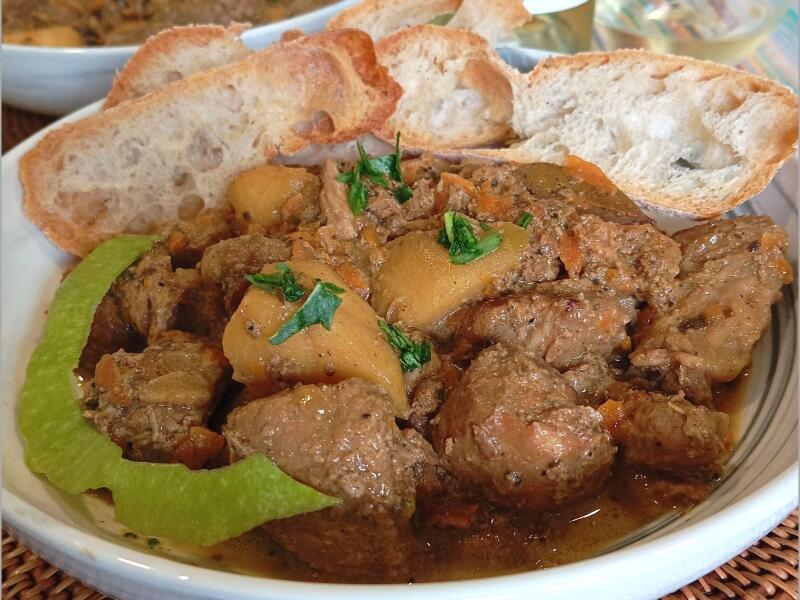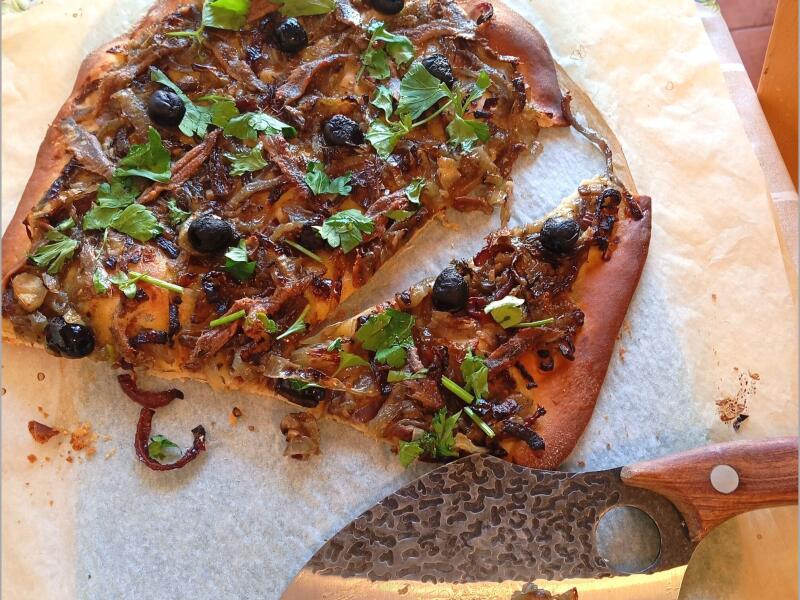In this modern interpretation of Beef Bourguignon, we introduce a delightful twist to the classic French dish by incorporating guanciale and meaty sheep tails. Inspired by the rich flavours of traditional ingredients, this recipe offers a fusion of savoury notes and hearty textures. Slow-cooked, over an open fire, in a medley of red wine, aromatic herbs, and wholesome vegetables, this dish promises a comforting and indulgent dining experience.
Beef Bourguignon, also known as Boeuf Bourguignon in French, is a classic French dish with a rich history deeply rooted in the culinary traditions of the Burgundy region in France.
I combined elements from Julia Child and Felicity Cloake’s recipes, infusing a touch of Italian influence by incorporating guanciale instead of bacon. Additionally, I introduced a South African “Boere” twist by using sheep tails, instead of oxtail, and cooking the dish over an open fire.
Ingredients
- For the red wine stock
- 1 bottle of fruity, relatively light dry red wine
- 1 onion, peeled and roughly chopped
- 1 large carrot, peeled and roughly chopped
- 2 celery stalk with leaves, roughly chopped
- 4 garlic cloves, peeled and smashed
- 3 bay leaves
- 2 cloves
- Small bunch of parsley
- 2 sprigs of thyme
- Tbsp olive oil
- 35g butter
- 300g guanciale or unsmoked bacon lardons or a thick piece of unsmoked bacon, cut into cubes
- 20 pearl onions, or 12 small shallots
- 18 baby carrots
- 250g button mushrooms
- 600g beef cheeks, cut into chunks
- 1kg meaty sheep tails
- 100ml brandy
- 2 to 3 cups beef stock
- 50g tomato paste
- 3 garlic cloves, peeled and thinly sliced
- 2 sprigs thyme
- 3 bay leaves
- All-purpose flour
- Salt and black pepper
Tip:
An easy way to peel the bay onions is to first soak it in boiling water for 15 minutes.

Method
Prepare red wine mixture: In a large Dutch oven, combine the wine, onion, carrot, smashed garlic, bay leaves, parsley, and thyme. Bring to a boil over an open fire, then simmer for 45 minutes until reduced by about half. Strain the liquid, discard the solids. Wipe the pot with a paper towel.

Fry guanciale: In the same pot, heat olive oil and butter over medium-high heat. Add the guanciale or bacon and fry until golden brown. Remove with a slotted spoon and set aside.

Add vegetables: Add the pearl onions and baby carrots to the Dutch oven and sauté until lightly golden. Remove and set aside.

Brown beef: Season the beef cheeks and sheep tails with salt and pepper, then coat in flour. Brown the beef in batches until deeply browned, then set aside.

Deglaze: Add brandy to the Dutch oven and deglaze the pan, scraping up any browned bits. Strain in the reduced wine mixture. Add 2 cups of beef stock, tomato paste, smashed garlic, thyme, and bay leaves.
Simmer: Return the beef cheeks and tails to the Dutch oven. Bring to a simmer, cover, and simmer for 3 hours. Add more stock if necessary.

Strip meat (optional): Remove the tails, strip the meat from the bones, and return it to the Dutch oven. Discard the thyme twigs and bay leaves.
Return vegetables: Add the pearl onions, mushrooms, and carrots to the Dutch oven. Simmer for an additional 30 minutes.
Serve: Stir in the guanciale or bacon, adjust seasoning to taste, and garnish with remaining parsley. Serve with (brown) rice or barley or noodles or mash or bread or any other starch.
We enjoyed this with noodles and a 2020 Hillcrest Saartjie Malbec.
From the Hillcrest website:
The Saartjie Malbec is a luscious single-vineyard wine displaying beautifully complex flavours of black cherry, Plums and Violets on the Nose and intense dark fruit and spices on the palate with balanced oak flavours complimenting the wine. This is a well-balanced wine with accessible supple tannins. Drinking well now but can be aged further.
The Saartjie range of single cultivar wines, are estate-grown and produced from small single blocks of vines. The utmost care and careful selection take place to ensure only the best wines are produced as a result. The Saartjie name was introduced after our winemaker’s Jack Russell pup, Saartjie.
Analysis:
Alc: 13.04%
RS: 2.4 g/l
TA: 5.3g/l
pH: 3.81

History
Originating as a peasant dish in the 19th century, Beef Bourguignon or Bœuf Bourguignon, also called Beef Burgundy, and Bœuf à la Bourguignonne, was originally a way for Burgundian farmers to tenderize tough cuts of beef by slow-cooking them in local Burgundy wine, a practice that also served to tenderize the meat. The dish was traditionally made with inexpensive and readily available ingredients, such as beef, onions, carrots, mushrooms, and wine, making it a hearty and economical meal for families.
The name “Bourguignon” refers to the Burgundy region of France, famous for its world-renowned wines, particularly Pinot Noir. The dish embodies the essence of Burgundian cuisine, characterized by rich, earthy flavours and a focus on local and seasonal ingredients.
Beef Bourguignon gained international recognition and popularity thanks in part to its inclusion in French chef Auguste Escoffier’s seminal cookbook, “Le Guide Culinaire,” published in 1903. However, it wasn’t until the mid-20th century that Beef Bourguignon became truly iconic, largely due to the influence of celebrated French chef Julia Child. In her groundbreaking cookbook, “Mastering the Art of French Cooking,” published in 1961, Child introduced Beef Bourguignon to American home cooks, helping to elevate its status as a beloved classic in both French and international cuisine.
Today, Beef Bourguignon remains a timeless favourite among food enthusiasts and home cooks worldwide. Its hearty flavours, comforting aromas, and rich history continue to make it a cherished symbol of French culinary tradition and gastronomic excellence.
Here is a short video on the process:



